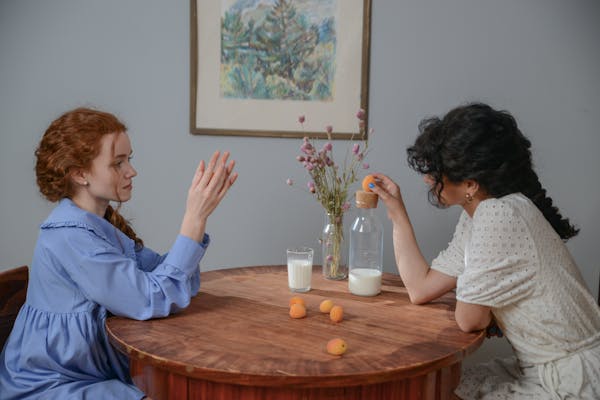At Home With Festen, the Parisian Design Duo Perfecting Low-Key Chic
When Le Pigalle opened in 2015, around the corner from my old apartment in Montmartre, it instantly became my hangout. Many urban hotels aim for cult status with locals. This one delivered precisely because it didn’t—and still doesn’t—feel like a hotel. The lobby, with its terrazzo floor, functions more like a giant café, with sober red velvet banquettes, bentwood chairs, and really good espresso and natural wine. Near the front door, bathed in daylight (when there is any in Paris), is an oversized deep-brown marble table surrounded by mismatched vintage chairs that say, I’m good for meetings if you must. Or for cruising the branding consultants and graphic designers squeaking past in interesting sneakers if you like. “We wanted people to come in and say, ‘Wait, there are rooms upstairs?’ ” says Hugo Sauzay, 34, one half of Festen, the interior design team that gave Le Pigalle the feeling that it had always been there, even when the marble bar was still brand-new. Some of the hotel’s creative team said, “ ‘No, the bar should be shiny’,” Sauzay recalls, “but Valéry Grégo, the owner, got what we were doing and said, ‘Let it stain.’ It gives it a history.”
Sauzay’s partner is Charlotte de Tonnac, also 34, whom he met at Paris’s École Camondo design school. There they ignored each other for four years only to couple up in the fifth, though they had slightly parallel lives, as they explain at their Marais office, just a few minutes’ walk from their shared apartment. Both were scouted to work as models as teenagers and used the money to pay for school, though de Tonnac, who grew up living all over France thanks to her father, a commercial director of a company that made car motors, grew disenchanted with the profession sooner than Sauzay. “I think I liked chocolates too much,” she says, laughing. But mostly she was bored. Not so for Sauzay, who had gotten on a plane only once before he started figuring in photo shoots and who still occasionally steps in front of the camera. “Suddenly I’d be in Japan or New York the next day, and I became curious and learned to adapt to new situations quickly and instinctively,” he says. “I developed an eye for things, like the Anglo-Saxon way of doing really shiny paint, or how Japanese lacquer mixes with light.” Working as a fit model for Miuccia Prada, Sauzay paid attention to how collections got off the ground and continued to develop his eye for detail. He admits this can get a bit obsessive: Watching movies at home has become an exercise in generosity for de Tonnac. “We have watched There Will Be Blood so many times,” she says with a smile. “Every three seconds I pause it and take a screenshot,” Sauzay admits. Another favorite is Steven Soderbergh’s series with Clive Owen, The Knick, set in Victorian New York, with its magnificent butt-joint tiles and opium dens. But Sauzay admits it can be anything: a Ben Stiller comedy, something with Bill Murray, pre–Wes Anderson. “I can watch a whole movie and never pay attention to the actors,” he says.
Knowing when to let a landmark building, or existing treasures, speak as loudly as your own work is a skill not many designers have mastered, especially young ones, and especially in our thirsty Instagram age, where every faucet is brass and every print tells a story and every paint color is boldly arresting, usually all at once. “We live in l’air du temps, but you have to keep your distance,” de Tonnac says. “We do mood boards for projects, and we have to be careful with Pinterest and Instagram. You see the same aesthetic all the time. We want a place to hang on 10 to 15 years at least.” Sauzay adds, “We’re afraid of the fashion effect on spaces. It can be two or three years before something we design sees the light.” It might look great at first, but if it’s too influenced by the color of the moment, “it’s already a has-been when it opens.”
“They have a culture of interior design that’s really French,” says Franck Durand, the art director spearheading a new five-star hotel near the Palais Royal, Château Voltaire, where Festen is doing the interiors. “They can handle classics with a lot of detachment.” The hotel’s walls will be lime plaster, complemented by ivory-painted wainscoting and recuperated old Burgundy stone tiles on the floors. Rather than varnish the oak furniture that will appear throughout, they’ll wax it, lending a subtle sheen to the natural grain and, like Le Pigalle’s marble, allowing traces of use as the years wear on. “We don’t want everything to be custom and perfect—it’s too cold,” Sauzay says.
Learning how to accommodate historic spaces elegantly is one hallmark of the best of old-country design—Jacques Grange and Axel Vervoordt come immediately to mind, two masters of restrained eclecticism who, it turns out, are North Stars to Festen. “We love to add our one little thing, even though we know a building will one day become something else,” says de Tonnac.








